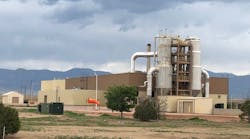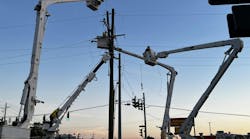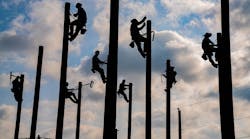Colorado Springs Utilities (CSU) is a combined electric/water/wastewater/gas municipal utility serving 600,000 customers in the Pikes Peak area. The company was founded in 1922 and takes sustainability seriously. Water is especially important, and CSU operates a state-certified lab that analyzes more than 12,000 samples per year from CSU plants and another 4,800 from customer homes.
The Clear Spring Ranch campus is one of the company’s largest sites and is home to a 1970s-era effluent treatment plant that CSU wanted to refurbish with modern low- and medium-voltage switchgear. The effluent treatment plant recycles and treats all wastewater streams from a 200-MW coal-fired plant, and a 480-MW 2-on-1 natural gas combined cycle plant. As a Zero Discharge facility, all water is treated, reused by the plant, or used as irrigation on a nearby crop-share to replenish the aquafer that supplies the plant with process water via a deep well pumping system.
As part of its commitment to sustainability, the utility is phasing out one of its coal-fired generating plants at another location with modern, gas-fired, low emission generators. The new units will be distributed around the coverage area to supply backup and charging power to battery-solar arrays. The new units will be moved to Clear Spring Ranch to eventually replace the coal-fired unit and will play an increasingly important role in maximizing CSU’s renewable energy output.
CSU also sees safety as part of making operations more sustainable. CSU has committed to the safety of their employees by a Medium Voltage Switchgear Retrofit Program started in 2015. All existing MV switchgear would be replaced with Arc Flash Resistant switchgear and any future projects would require it. The Zero Discharge Plant is the last in the fleet to receive this modification, and the only one to be also retrofitted with Low Voltage, Arc Quenching technology. According to Shawn Timothy, Sr. Technical Project Manager for CSU, one key requirement for the new switchgear was that it be arc-resistant. ABB pioneered this technology, and after a competitive bidding process, CSU chose ABB’s LV and MV products to replace the aging equipment.
Footprint was another concern. The new gear had to be located near underground feeds below concrete floors while roof girders limited the height of the new equipment. The confined space would also require plenums to direct the discharge of an arc flash event upward through openings in the exterior wall that also had to be situated between girders. The LV and MV lineups were also required to be integrated both electrically and with communications and controls.
Given the entire project would be conducted during the pandemic, it was clear that in-person factory acceptance testing would be impossible. So, ABB arranged for FAT to be conducted via videoconference, which not only solved the problem but eliminated several days and associated travel costs for CSU and ABB personnel. ABB is now looking to offer video FAT as an option for all customers going forward.
The new gear arrived by early February 2021 from two of ABB’s factories in Mexico, but there was one more kink to work out: despite the designs calling for access to the rear of the equipment, there was a steel-framed and composite panel wall directly behind the installation site where the equipment would go. CSU and ABB worked together to modify the wall with removable access panels that provide permanent rear access for future motor testing.
By April, the installation and commissioning were complete, and CSU energized their new switchgear without any issues.


